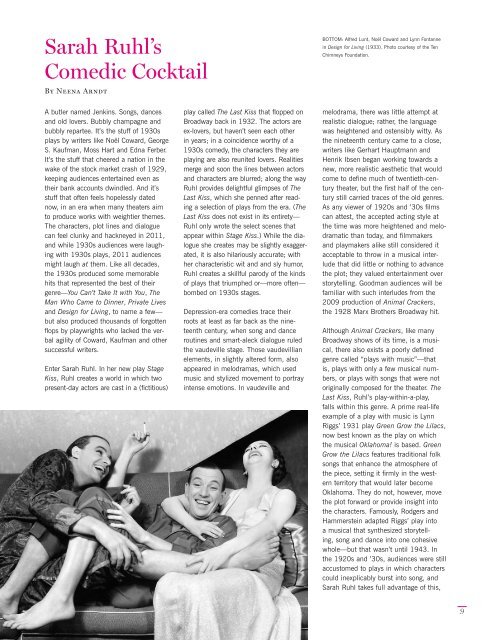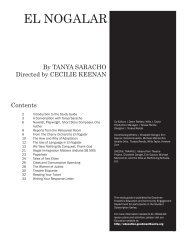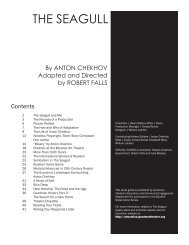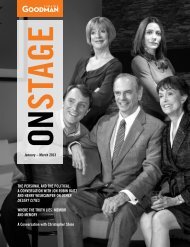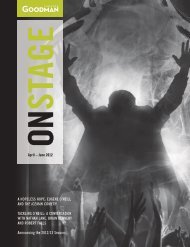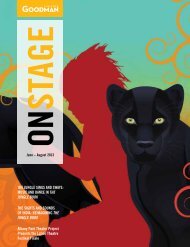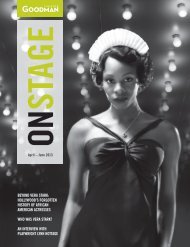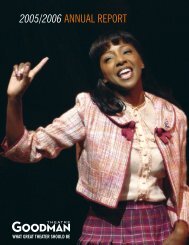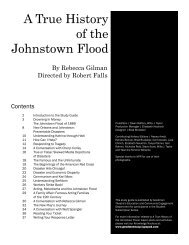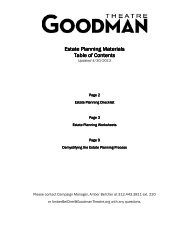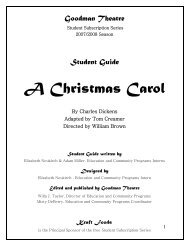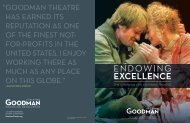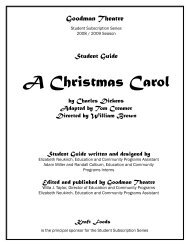Stage Kiss - Goodman Theatre
Stage Kiss - Goodman Theatre
Stage Kiss - Goodman Theatre
You also want an ePaper? Increase the reach of your titles
YUMPU automatically turns print PDFs into web optimized ePapers that Google loves.
Sarah Ruhl’s<br />
Comedic Cocktail<br />
By Neena Arndt<br />
BOTTOM: Alfred Lunt, Noël Coward and Lynn Fontanne<br />
in Design for Living (1933). Photo courtesy of the Ten<br />
Chimneys Foundation.<br />
A butler named Jenkins. Songs, dances<br />
and old lovers. Bubbly champagne and<br />
bubbly repartee. It’s the stuff of 1930s<br />
plays by writers like Noël Coward, George<br />
S. Kaufman, Moss Hart and Edna Ferber.<br />
It’s the stuff that cheered a nation in the<br />
wake of the stock market crash of 1929,<br />
keeping audiences entertained even as<br />
their bank accounts dwindled. And it’s<br />
stuff that often feels hopelessly dated<br />
now, in an era when many theaters aim<br />
to produce works with weightier themes.<br />
The characters, plot lines and dialogue<br />
can feel clunky and hackneyed in 2011,<br />
and while 1930s audiences were laughing<br />
with 1930s plays, 2011 audiences<br />
might laugh at them. Like all decades,<br />
the 1930s produced some memorable<br />
hits that represented the best of their<br />
genre—You Can’t Take It with You, The<br />
Man Who Came to Dinner, Private Lives<br />
and Design for Living, to name a few—<br />
but also produced thousands of forgotten<br />
flops by playwrights who lacked the verbal<br />
agility of Coward, Kaufman and other<br />
successful writers.<br />
Enter Sarah Ruhl. In her new play <strong>Stage</strong><br />
<strong>Kiss</strong>, Ruhl creates a world in which two<br />
present-day actors are cast in a (fictitious)<br />
play called The Last <strong>Kiss</strong> that flopped on<br />
Broadway back in 1932. The actors are<br />
ex-lovers, but haven’t seen each other<br />
in years; in a coincidence worthy of a<br />
1930s comedy, the characters they are<br />
playing are also reunited lovers. Realities<br />
merge and soon the lines between actors<br />
and characters are blurred; along the way<br />
Ruhl provides delightful glimpses of The<br />
Last <strong>Kiss</strong>, which she penned after reading<br />
a selection of plays from the era. (The<br />
Last <strong>Kiss</strong> does not exist in its entirety—<br />
Ruhl only wrote the select scenes that<br />
appear within <strong>Stage</strong> <strong>Kiss</strong>.) While the dialogue<br />
she creates may be slightly exaggerated,<br />
it is also hilariously accurate; with<br />
her characteristic wit and and sly humor,<br />
Ruhl creates a skillful parody of the kinds<br />
of plays that triumphed or—more often—<br />
bombed on 1930s stages.<br />
Depression-era comedies trace their<br />
roots at least as far back as the nineteenth<br />
century, when song and dance<br />
routines and smart-aleck dialogue ruled<br />
the vaudeville stage. Those vaudevillian<br />
elements, in slightly altered form, also<br />
appeared in melodramas, which used<br />
music and stylized movement to portray<br />
intense emotions. In vaudeville and<br />
melodrama, there was little attempt at<br />
realistic dialogue; rather, the language<br />
was heightened and ostensibly witty. As<br />
the nineteenth century came to a close,<br />
writers like Gerhart Hauptmann and<br />
Henrik Ibsen began working towards a<br />
new, more realistic aesthetic that would<br />
come to define much of twentieth-century<br />
theater, but the first half of the century<br />
still carried traces of the old genres.<br />
As any viewer of 1920s and ’30s films<br />
can attest, the accepted acting style at<br />
the time was more heightened and melodramatic<br />
than today, and filmmakers<br />
and playmakers alike still considered it<br />
acceptable to throw in a musical interlude<br />
that did little or nothing to advance<br />
the plot; they valued entertainment over<br />
storytelling. <strong>Goodman</strong> audiences will be<br />
familiar with such interludes from the<br />
2009 production of Animal Crackers,<br />
the 1928 Marx Brothers Broadway hit.<br />
Although Animal Crackers, like many<br />
Broadway shows of its time, is a musical,<br />
there also exists a poorly defined<br />
genre called “plays with music”—that<br />
is, plays with only a few musical numbers,<br />
or plays with songs that were not<br />
originally composed for the theater. The<br />
Last <strong>Kiss</strong>, Ruhl’s play-within-a-play,<br />
falls within this genre. A prime real-life<br />
example of a play with music is Lynn<br />
Riggs’ 1931 play Green Grow the Lilacs,<br />
now best known as the play on which<br />
the musical Oklahoma! is based. Green<br />
Grow the Lilacs features traditional folk<br />
songs that enhance the atmosphere of<br />
the piece, setting it firmly in the western<br />
territory that would later become<br />
Oklahoma. They do not, however, move<br />
the plot forward or provide insight into<br />
the characters. Famously, Rodgers and<br />
Hammerstein adapted Riggs’ play into<br />
a musical that synthesized storytelling,<br />
song and dance into one cohesive<br />
whole—but that wasn’t until 1943. In<br />
the 1920s and ’30s, audiences were still<br />
accustomed to plays in which characters<br />
could inexplicably burst into song, and<br />
Sarah Ruhl takes full advantage of this,<br />
9


